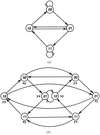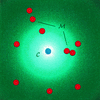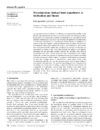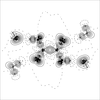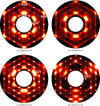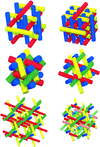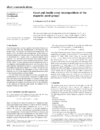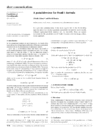issue contents
January 2001 issue

Cover illustration: Graphical representation of density modification due to third-order terms b113 = -b223 (point group ![]() ) in the Gram-Charlier series expansion of a Gaussian atomic probability density function. Courtesy of W. F. Kuhs.
) in the Gram-Charlier series expansion of a Gaussian atomic probability density function. Courtesy of W. F. Kuhs.
obituaries
Free 

research papers
The question of crystalline ground states for polytypes is considered, using reasoning based on the symmetries of the modular layers. It is found that polytypes in the SiC family must have crystalline ground states; but this conclusion does not hold for the other families studied (CdI2, GaSe, micas and kaolins).
A fundamental geometric principle opens up non-classical qualitative ways of investigating orientational disorder.
Copper oxysalt minerals are considered as the salts of hypothetical copper acids with characteristic Cu-containing structural units. Magnetic susceptibility data for a series of minerals were analyzed from the viewpoint of the developed extended structural classification scheme for cuprates.
The joint probability distribution method is applied to define phases for the one-wavelength anomalous-scattering techniques.
The determination of the space-group symmetry of a crystal from powder diffraction data is placed on a quantitative basis using an algorithm based upon probability theory.
A method is presented that can be used to estimate some individual phases with special values of 0, π or  using the SIR data in macromolecular structure determination.
using the SIR data in macromolecular structure determination.
`Quasiforbidden' reflections are utilized for an unambiguous determination of structure refinement parameters of the silicon carbide polytypes 4 and 6
and 6 . The determination was accomplished by a comparison of measured and calculated Renninger scans close to three-beam nodes.
. The determination was accomplished by a comparison of measured and calculated Renninger scans close to three-beam nodes.
A detailed analysis of a three-beam diffraction dispersion surface is performed to study the forbidden wavefields of thick-crystal reflections. It is demonstrated that Bragg-case three-beam diffraction from thick crystals can be regarded as either a four-mode diffraction process for Bragg–Laue geometry or a two-mode process for Bragg–Bragg geometry.
The concept of extracting wavefunctions from experimental data is critically examined and past efforts are reviewed. A general and systematically improvable method for fitting a wavefunction to experimental data is also proposed.
A wavefunction has been calculated for the oxalic acid dihydrate molecule using accurate low-temperature X-ray charge-density data. Derived properties from the constrained Hartree–Fock wavefunction fragments are also presented.
A recently developed method for fitting a Monte Carlo computer simulation model to observed single-crystal diffuse X-ray scattering data has been used to study the diffuse scattering in benzil. The analysis has shown that the diffuse lines, which feature so prominently in the observed diffraction patterns, are due to strong longitudinal displacement correlations transmitted from molecule to molecule via a network of contacts involving hydrogen bonding.
short communications
There are six homogeneous cubic packings of non-intersecting rods (cylinders) with the positions of the axes fixed by symmetry (invariant). Their symmetries and coordinates are given.
A table giving the statistics of the visible symmetry point groups for all non-isomorphic 4- to 8-hedra and simple 9- to 11-hedra is presented.
Mathematical properties of crystallographic magnetic point groups are tabulated.
The Moore–Penrose generalized inverse to Frank's formula for grain boundary dislocation content is derived using a simple vector approach.
addenda and errata
Free 

international union of crystallography
Free 



 journal menu
journal menu










